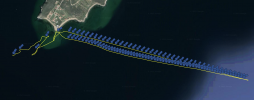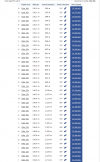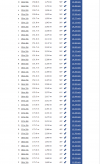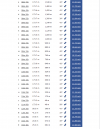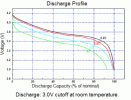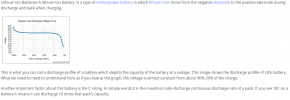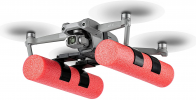Here's my assessment of the whole flight.
Flying over the sea (where there are no obstacles) with RTH height set at 175 metres
Two minutes into the flight, at 130 metres, you are only able to fly at 9.6 metres/sec with full right stick.
As the still air top speed is 15 m/s, that should have been a warning about wind speed.
At 4:40, you were higher at 152m and could only make 7.5 metres at full stick.
At 6:50.9 you reached your target, 2.7 km from home and the battery is down to 38%.
You initiate RTH which takes the drone up to 130 metres (where the wind speed is higher) but there is a tailwind for the return trip.
Drone comes home at 12 m/s, arriving at 11:00.
Battery is now at 18%, drone is now 173 metres high.
Because you have no idea of the importance of a safety margin when flying at sea and are completely oblibious to the wind speed and direction, you decide to keep flying.
You start a flying west (which means your return will be against a headwind - but you don't care)
At 12:00, battery has reached 14%, the drone is 491 metres from home, 55 metres high and you turn back toward home.
At full stick, the drone makes 3.2 m/s towards home so you go to (battery burning) Sport Mode and speed increases to 5.5-8 m/s fighting against the gusty wind.
After only 7 seconds the battery is down to 11% and critical low voltage.
It starts to autodescend.
The drone is still 393 metres from shore and 58 metres up (you don't show any understanding of the way the wind is stronger at higher altitudes).
Fighting against the autolanding with full left stick and using full right stick to head toward land, you get within 156 metres of land at 13:10 & 6%.
The speed has been 1-2 m/s.
But at 13:10, with the battery getting weaker, the drone starts going backwards at 4.9 m/s, despite full right stick.
At 14:26.4 the battery hits 0% with the drone now 350 metres out and being blown further away.
The sorry story ends with the drone 700 metres out and sinking at 16:55.5.
Flying over the sea (where there are no obstacles) with RTH height set at 175 metres
Two minutes into the flight, at 130 metres, you are only able to fly at 9.6 metres/sec with full right stick.
As the still air top speed is 15 m/s, that should have been a warning about wind speed.
At 4:40, you were higher at 152m and could only make 7.5 metres at full stick.
At 6:50.9 you reached your target, 2.7 km from home and the battery is down to 38%.
You initiate RTH which takes the drone up to 130 metres (where the wind speed is higher) but there is a tailwind for the return trip.
Drone comes home at 12 m/s, arriving at 11:00.
Battery is now at 18%, drone is now 173 metres high.
Because you have no idea of the importance of a safety margin when flying at sea and are completely oblibious to the wind speed and direction, you decide to keep flying.
You start a flying west (which means your return will be against a headwind - but you don't care)
At 12:00, battery has reached 14%, the drone is 491 metres from home, 55 metres high and you turn back toward home.
At full stick, the drone makes 3.2 m/s towards home so you go to (battery burning) Sport Mode and speed increases to 5.5-8 m/s fighting against the gusty wind.
After only 7 seconds the battery is down to 11% and critical low voltage.
It starts to autodescend.
The drone is still 393 metres from shore and 58 metres up (you don't show any understanding of the way the wind is stronger at higher altitudes).
Fighting against the autolanding with full left stick and using full right stick to head toward land, you get within 156 metres of land at 13:10 & 6%.
The speed has been 1-2 m/s.
But at 13:10, with the battery getting weaker, the drone starts going backwards at 4.9 m/s, despite full right stick.
At 14:26.4 the battery hits 0% with the drone now 350 metres out and being blown further away.
The sorry story ends with the drone 700 metres out and sinking at 16:55.5.




